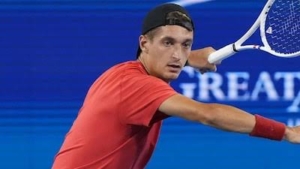Atmane’s Evolution: From Banging to Relentless Patterns
Atmane’s Evolution: From Banging to Relentless Patterns
The newly expanded 96-player draw in Cincinnati gave Térence Atmane a lifeline — a spot in qualifying. He seized it, beating Yoshihito Nishioka to reach the main draw, then taking down Flavio Cobolli, João Fonseca, Taylor Fritz, and Holger Rune.
Cincinnati’s fast, low-bouncing hard courts, with their skidding ball speed, are tailor-made for his game. The surface rewards his first-strike instincts, amplifies his lefty serve, and keeps opponents from settling into long exchanges.
The Weapons Were Always There
Atmane has never lacked firepower — a left-handed serve that carves the court wide, a forehand that can rip through defenses, and angles that drag opponents into awkward recovery patterns.
What he hasn’t had is stability. His Challenger career yielded a 74–48 record before Cincinnati, but in 2025 he was just 19–10 despite two titles, his results swinging wildly from dangerous to erratic.
The last two seasons brought turbulence: a near-default at the 2024 French Open after hitting a spectator, the loss of his Asics sponsorship, and boos from the Philippe-Chatrier crowd after a flat 2025 French Open loss to Richard Gasquet.
A Mental Reset
After the Gasquet defeat, Atmane told Tennis Channel he wanted to be “more healthy, more happy.” It marked a shift from chasing only results to building daily habits that sustain performance.
He’s traded emotional volatility for adaptive mental strategies — match-day rituals, reset cues, and positive self-talk (shades of Draper) — giving his raw power a framework for consistency.
Inside the Patterns: How He’s Winning Points
Wide Forehand Setup: Lefty Geometry: One of his most effective plays this week has been the wide forehand setup — a nod to the Nadal variation, but executed with his own aggression. From the ad court, he serves wide to the backhand, forcing a stretched return. That gives him time to step around and crack a forehand crosscourt, opening the angle even further. With his opponent pulled far off the court, the next ball is an inside-out forehand into open space — precision meets geometry.
Short/Long Combo: Disrupting the Rally Rhythm: When rallies settle into neutral patterns, Atmane uses the short/long combo. He’ll carve a short, angled forehand that yanks his opponent forward, often on the run. As they scramble back, he picks his strike — a passing shot threading the gap or a deep lob that flips the point back in his favor. It’s a rhythm-breaker that unsettles even the most reliable baseliners.
Wrong-Foot Redirect: Timing Meets Deception: His improved timing and awareness are on full display with the wrong-foot backhand redirect. Taking the ball early, often as his opponent moves back to center, he sends it down the line — not into open space, but directly into their recovery path. The surprise forces an awkward adjustment, creating errors or easy finishes at the net.
Wrap
Cincinnati could be the turning point that transforms Térence Atmane from an unpredictable outsider into a player with top-20 potential.
His next challenge is Jannik Sinner in the semifinals — a meeting of two players with contrasting styles and very different routes to this stage.

Source: Cincinnati Open




